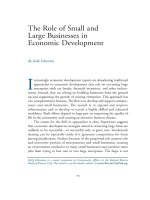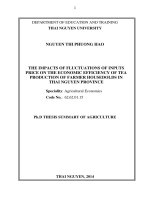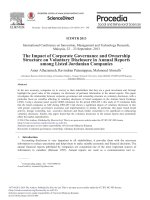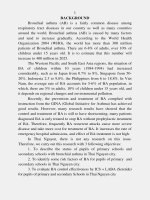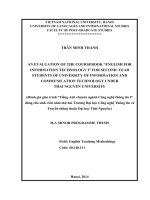impact of financial management on the profitability of small and medium trade and service enterprises in thai nguyen province
Bạn đang xem bản rút gọn của tài liệu. Xem và tải ngay bản đầy đủ của tài liệu tại đây (94.96 KB, 12 trang )
IMPACT OF FINANCIAL MANAGEMENT AND FINANCIAL
ASPECTS ON THE PROFITABILITY OF SMALL AND MEDIUM
TRADE AND SERVICE ENTERPRISES
IN THAI NGUYEN PROVINCE
A Dissertation
Presented to
The Faculty
Graduate School
Southern Luzon State University
Lucban, Quezon
In Partial Fulfillment
of the Requirements for the Degree
Doctor of Business Administration
by
PHAM ANH NGOC (RANDY)
2013
1
Chapter 1
INTRODUCTION
BACKGROUND OF THE STUDY
According to Vietnam Chamber Of Commerce and Industry (VCCI), SMEs have
contributed considerably to growing GDP and creating jobs for labour-age.
Originating from recognition of the increasingly important role and contribution of
SMEs as well as the recent promotion and supporting policy on developing SMEs, this
research study
the Impact of Financial Management and Financial Aspects on the
Profitability of Small and Medium Trade and Service Enterprises in Thai Nguyen
Province.
STATEMENT OF THE OBJECTIVES
This study has the following objectives:
1) To determine the profile of the respondents in terms of the following position :
Owner, manager, chief- accounting.
2) To Identify the financial management practices of the company in terms of the
following areas: Accounting information system, Working capital management, Fixed asset
management.
3) To assess the company in terms of the following financial aspects: Liquidity,
Financial leverage, Business activity
4) To know the relationship of financial management practices and financial aspects
to the company’s profitability
5) To develop a model for the SME’s profitability
6) To propose solutions to improve the company’s and SME’s profitability
This study has four research questions
1) How important are financial management practices and financial aspects to SME’s
profitability?
2) What are the relationships between financial management practices, financial
aspects and SME profitability?
3) How do financial management practices and financial aspects affect SME’s
profitability?
4) What action can improve profitability of SME in Thai Nguyen province?
2
HYPOTHESIS
This study has four hypotheses
H1: SME’s Profitability is negatively related to the cash ratio.
H2: SME’s Profitability is negatively related to the debt ratio.
H3: SME’s Profitability is positively related to total asset turnover.
H4: SME’s Profitability is positively related to the efficiency of financial management
practices.
SIGNIFICANCE OF THE STUDY
This study examines the impacts of financial management practise and finance aspacts
on SME’s profitability. Results will indicate relationships between financial management,
finance aspacts and SME’s profitability and will assist managers to improve their
profitability .
SCOPE AND LIMITATIONS OF THE STUDY
This research is designed as a causal research in which a sample of 120 SMEs Trade
and Service Enterprises in Thai Nguyen Province in 2011.
The context of financial management practices in this study includes the following
areas: Accounting information systems, Working capital management, and fixed asset
management.
Financial aspects in this study includes: Liquidity measured by cash ratio; Financial
leverage measured by Debt-to-equity ratio; Business activity measured by Total asset
turnover;
Profitability measured by average of return on sales, return on assets and return on
equity.
DEFINITION OF TERMS
- Small and medium-sized
- Financial management
- Financial management objectives
- Efficient financial management
- Manager.
- Financial aspects
- SME’s profitability
3
Chapter 2
REVIEW OF RELATED LITERATURE AND STUDIES
The objectives of this chapter are to review previous research related to the areas of
financial management practices, financial aspects, and profitability of SMEs and to build a
model of the impact of financial management practices and financial aspects on SME
profitability.
This chapter is structured into nine main sections. Section 2.1, 2.2 reviews definitions
of SMEs, both qualitative and quantitative. Section 2.3, 2.4 and 2.5 respectively review the
previous studies on financial management practices, financial aspects and SME profitability
conducted by previous researchers in the developed economies. Section 2.7 concentrates on
examining the relationships between financial management practices, financial aspects and
SME profitability. Section 2.8 provides the model of impact of financial management and
financial aspects on SME profitability. Lastly, section 2.9 develops a model of the impact of
financial management practices and financial aspects on SME profitability and conceptual
framework
INDEPENDENT VARIABLES
DEPENDENT VARIABLES
Financial management practices:
Accounting information system
Working capital management
Fixed asset management
Financial aspects:
SME profitability ratios is
→
Average of:
Return on sales
Return on assets
Return on equity
Cash ratio
debt-to-equity
Total asset turnover
4
Chapter 3
METHODOLOGY
RESEARCH DESIGN
This study is designed to investigate the impact of the financial management practices
and financial aspects on SME profitability in Thai Nguyen province. Thus causal research
was implemented. In this research, both survey and secondary data methods are used in
combination.
Survey was chosen as a research technique to investigate financial management
practices of SMEs
The secondary data method was used to examine the financial aspects of SMEs.
SAMPLING DESIGN AND TECHNIQUES
Simple random sampling technique was used to draw a sample of 120 SMEs located in
Thai Nguyen City for data collection via personal interview (Slovin's formula
n=N/(1+Ne2)=1854/(1+1854*0.9 2)≈120 where e =0.9 is std.Error, N=1854).
RESEARCH INSTRUMENT
Dependent variables
Profitability is viewed as the dependent variable and was measured by three indicated
variables including return on sales (ROS), return on assets (ROA), and return on equity
(ROE).
Independent variables
The independent variables include variables used to define the efficiency of financial
management practices and financial aspects of SMEs.
There are three independent variables related to financial management practices
1) Accounting information systems (AIS)
2) Working capital management (WCM)
3) Fixed-asset management (FAM)
There are three independent variables related to financial aspects
- Cash ratio (CAR)
- Debt ratio (DER)
- Total asset turnover (TAT)
Model development for this study as follows:
PRO = f(CAR, DER, TAT, AIS,WCM,FAM)
where:
5
PRO: Profitability = Average of ROS, ROA, and ROE
ROS: Return on sales (Net profit/Sales)
ROA: Return on assets (Net profit/Total assets)
ROE: Return on equity (Net profit/Equity)
CAR: Cash ratio (Cash/Current liabilities)
DER: Debt to equity ratio (Total debt/Equity)
TAT: Total asset turnover (Sales/Total assets)
AIS: The efficiency of Accounting information system
WCM: The efficiency of Working capital management (Average of Cash management
practices, Receivable management practices and Inventory management practices)
FAM: The efficiency of Fixed-asset management
DATA GATHERING PROCEDURE
The secondary data in financial statement were used to derive the financial ratios
measuring liquidity, financial leverage, business activity and profitability of SMEs.
Primary data was collected by questionnaire and respondents are owner, manager or
chief - accountant of SMEs.
DATA PROCESSING METHOD
SPSS and Excel software will help this data transformation easily and quickly.
STATISTICAL TREATMENT
The correlation matrix would be used to present the measures of association among the
variables.
Weighted mean was utilized to describe the perception of respondents on the influence
of financial management variables.
- Multiple regression analysis is used to investigate simultaneous effects of cash ratio
(CAR), debt ratio (DER), total asset turnover (TAT) and efficiency of financial management
practice (AIS, WCM, FAM) on SME profitability (PRO).
6
Chapter 4
PRESENTATION, ANALYSIS AND
INTERPRETATION OF DATA
THE PROFILE OF THE RESPONDENTS
- The form of ownership includes: Joint stock companies, Limited companies, Private
enterprise
- The position of respondent in the company are Owner, Manager or Chief-accountant
- The highest educational attainment of respondents are mainly Bachelor degree and lower
- Almost respondents attendance to financial management – related trainings but frequency
is not usually.
ASSOCIATIVE ANALYSIS OF THE RESEARCH STUDY
1) Correlation matrix as shown in Table 4.23 is used to determine whether
relationships between financial aspects, financial management practices and profitability.
Table 4.23: Correlation matrix of PRO and independent variables
PRO
CAR
DEB
TAT
AIS
WCM
FAM
PRO
1.000
-0.946
0.072
0.822
0.861
0.865
0.856
CAR
-0.946
1.000
-0.008
-0.769
-0.809
-0.845
-0.789
DEB
0.072
-0.008
1.000
0.150
0.051
0.007
0.044
TAT
0.822
-0.769
0.150
1.000
0.682
0.571
0.612
AIS
0.861
-0.809
0.051
0.682
1.000
0.755
0.784
WCM
0.865
-0.845
0.007
0.571
0.755
1.000
0.836
FAM
0.856
-0.789
0.044
0.612
0.784
0.836
1.000
Correlation is significant at the 0.01 level (2-tailed)
- The relationships between profitability and accounting information system, working
capital management practices and
fixed asset management practices are significantly
positive with respective correlation coefficients r = 0.861; 0.865; and 0.856.
- Correlation between profitability and total asset turnover with r = 0.822 and between
profitability and cash ratio is significantly negative with correlation coefficients r = - 0.946.
2) Multiple regression analysis was used to determine whether independent variables
(CAR, DER, TAT, AIS, WCM, FAM ) simultaneously impact the dependent variable (PRO).
7
Table 4.24: SME profitability regression model using profitability
as dependent variable
Unstandardized
Coefficients
Model
Std.
B
1
Error
StandardizedCoefficients
t
Sig.
0.190
.850
Beta
0.054
0.286
CAR
-2.094
0.266
-0.390
-7.873
.000
DEB
0.076
0.083
0.018
0.917
.739
TAT
1.092
0.149
0.236
7.319
.000
AIS
0.011
0.003
0.133
3.647
.000
WCM
0.010
0.003
0.166
3.808
.000
FAM
0.013
0.003
0.160
4.135
.000
(Constant)
Model Summary
Model
R
1
979 a
R
Adjusted R
Square
Square
0.959
0.957
Std. Error of the Estimate
0.08134
ANOVA(b)
Sum of
Model
1
Squares
df
Mean Square
Regression
17.446
6
2.908
Residual
0.748
113
0.007
Total
18.194
119
F
Sig.
439.525 .000(a)
a. Predictors: (Constant), FAM, DER, TAT, AIS, WCM, CAR
b. Dependent Variable: PRO (%)
In summary, the results of multiple regression analysis in Table 4.24 revealed that
SME profitability was influenced by financial aspects and financial management practices at
the significance level of 0.0001, and 95.9 percent of variation in SME profitability (R2 =
0.959) can be accounted for variance in financial aspects and financial management
practices. Specifically:
- Cash ratio is negatively related to SME profitability at a significance level of 0.0001
and with the standardized correlation coefficient of – 0.390.
- Debt ratio was not found to be related to SME profitability.
8
- Total asset turnover is positively related to SME profitability at a significance level
of 0.0001 and with the standardized correlation coefficient of 0.236.
- All variables of financial management practices (AIS, WCM, and FAM) are
positively related to SME profitability at a significance level of 0.0001 and with the
standardized correlation coefficients of 0.133, 0.166 and 0.160 respectively.
After removing the debt ratio and rerunning the program, the results of multiple
regression analysis are shown in Table 4.27.
T able 4.27: Regression model of SME profitability after removing debt ratio
Model
Unstandardized
Standardized
Coefficients
Coefficients
Std.
B
1
(Constant)
t
Sig.
0.189
.850
Beta
Error
0.054
0.286
CAR
-2.057
0.263
-0.383
-7.830
.000
TAT
1.121
0.146
0.240
7.706
.000
AIS
0.011
0.003
0.133
3.692
.000
WCM
0.010
0.003
0.166
3.834
.000
FAM
0.013
0.003
0.161
4.168
.000
Model Summary
Model
R
1
0.979a
R
Square
Adjusted R Square
Std. Error of the Estimate
0.957
0.08128
0.959
ANOVA(b)
Model
Sum of Squares df
Mean
F
Sig.
Square
1
Regression
17.441
5
3.488
Residual
0.753
114
0.007
Total
18.194
119
527.997 .000(a)
a. Predictors: (Constant), FAM, DER, TAT, AIS, WCM, CAR
b. Dependent Variable: PRO (%)
Table 4.27 reveals that all statistical parameters including F-value, t-test statistics and
standard error of estimate have been significantly improved after removing the debt ratio
from the multiple regression equation.
9
Chapter 5
SUMMARY, FINDINGS, CONCLUSIONS
AND RECOMMENDATIONS
SUMMARY
This research model indicated that variation in SME profitability of Thai Nguyen
province could be explained by the changes in:
1) Cash ratio
2) Total asset turnover
3) Efficiency of accounting information system
4) Efficiency of working capital management
5) Efficiency of fixed asset management
FINDINGS
1) The position of respondent in company is mainly chief – accountant (90.8 percent).
2) The highest educational of respondent is Bachelor degree and lower (95 percent)
3) Accounting information system with an average weighted mean of 3.27
4) Cash management with an average weighted mean of 3.29
5) Receivable management with an average weighted mean of 3.16
6) Inventory management with an average weighted mean of 3.41
7) Fixed asset management with an average weighted mean of 3.16
8) Carh ratio with a mean of 0.67
9) Debt to equity with a mean of 0.60
10) Total asset turnovers with an average of 0.55 times.
11) 79 of 120 SMEs surveyed (65.8%) were profitable and the remainder (34.2%)
were not profitable.
12) Accounting information system, working capital managerment, fixed asset
management were found to be significantly related to SME profitability with Pearson’s
correlation coefficients of 0.861; 0.865 and 0.856 respectively at a 0.01 significance level.
13) SME profitability was found to be negatively related to cash ratio with the
correlation coefficient of minus 0.946 at a 0.01 significance level.
14) SME profitability was found to be positively related to total asset turnover with a
correlation coefficient of 0.822 at a significance level of 0.01.
15) SME profitability was not found to be significantly related to debt ratio.
10
16) After removing the debt ratio and rerunning the program, the model of SME
profitability was revised by the following changes:
PRO = -2.094CUR+1.092TAT+0.011AIS+0.010WCM+0.013FAM
CONCLUSIONS
Based on the findings, the researcher came up with the following conclusions:
1) Almost SMEs use employed accountants in their businesses.
2) Chief-accountant still plays an important role in controlling financial position
3) Almost SMEs have frequently applied computers in their accounting
4) Experience is viewed as more important than theory in practicing cash management.
5) Selling products or services on credit is a common trend for SMEs in Thainguyen
province.
6) Determine inventory levels based on owner/manager’s experience.
7) SMEs always evaluate capital investment projects before making decisions on
investment.
8) SMEs of Thainguyen province is difficult in liquidity.
9) SMEs in Thainguyen province have not extreme difficulty in finding outside
financing sources from commercial banks
10) Efficiency in utilizing total assets by SMEs was very low in 2011.
11) The more efficient financial management practices, the higher profitability
12) SMEs with higher cash ratios tend to less profitable
13) SMEs with high total asset turnover are expected to produce more profit.
14) SME profitability was not found to be significantly related to debt ratio.
RECOMMENDATIONS
Based from the findings of the study, the following are recommended:
1) Efficiency of financial management could lead to high profits. Therefore raising the
efficiency of financial management is considered an effective tool for improving and
increasing profitability of SMEs. Specifically, the model indicates the the following financial
management components are positively correlated to SME profitability:
- Efficiency of accounting information systems
- Efficiency of working capital management including cash management, receivable
management, inventory management. Specifically, SMEs need to apply theory of inventory
and theory of target cash balance. Those are low in efficiency.
- Efficiency of fixed asset management
11
2) High cash ratios tend to high liquidity and negatively affect to profitability due to
cash in hand do not generate profitability. If SMEs change cash in hand into cash in bank
then they still maintain liquidity and earn interest from bank therefore increasing profitability
of SMEs. However, this does not mean the cash ratio should be continuously lowered to
raising profitability because such actions will adversely affect liquidity.
3) High total asset turnover leads to higher profitability for SMEs.
Total asset
turnover is defined as the ratio between net sales and total assets. Therefore increasing net
sales or decreasing total assets will cause total asset turnover to increase. Selling assets are
not necessary for business operations. SMEs need to efforts to increase the efficiency of
utilizing total assets and increase total asset turnover. In addition, efforts of marketing, sales
management, new product development and the likes will increase net sales, as a result,
increase total asset turnover and profitability
4) Change discrimination between SMEs and large companies, between state and nonstate SMEs in granting loans. State and large companies are always landed capital with
preferential interest rates lower than other businesses. This leads to unfair competition and
SMEs take more risks when it enter the market.
5) Provide training programs about financial management skills for the owners and
managers of SMEs in working capital management field because experience is viewed as
more important than theory in this now.
6) Findings on financial management practices and financial aspects of SMEs help
teaching and training organization personnel to understand the behavior of SMEs in the field
of financial management. This will be basis for developing more appropriately training
programs for owners and managers of SMEs.
12
